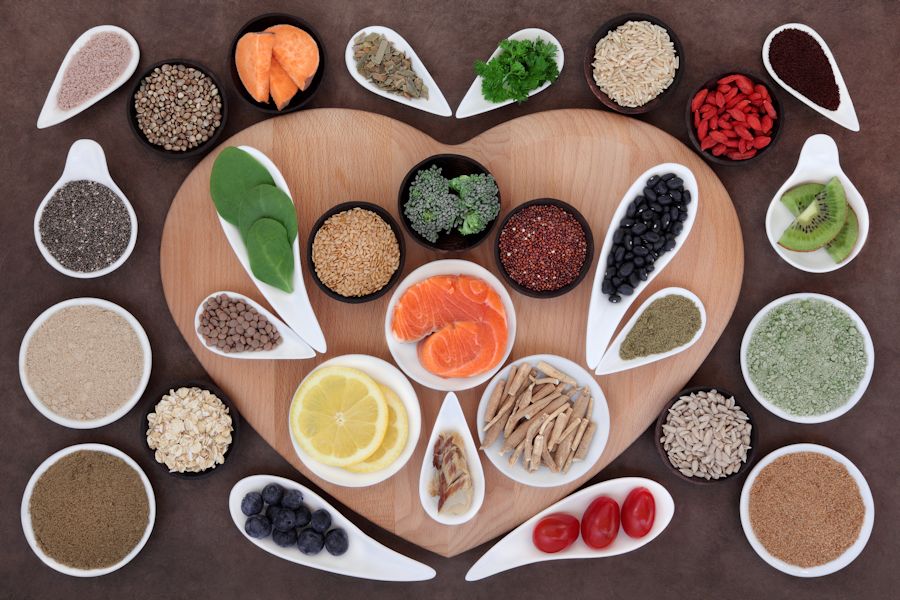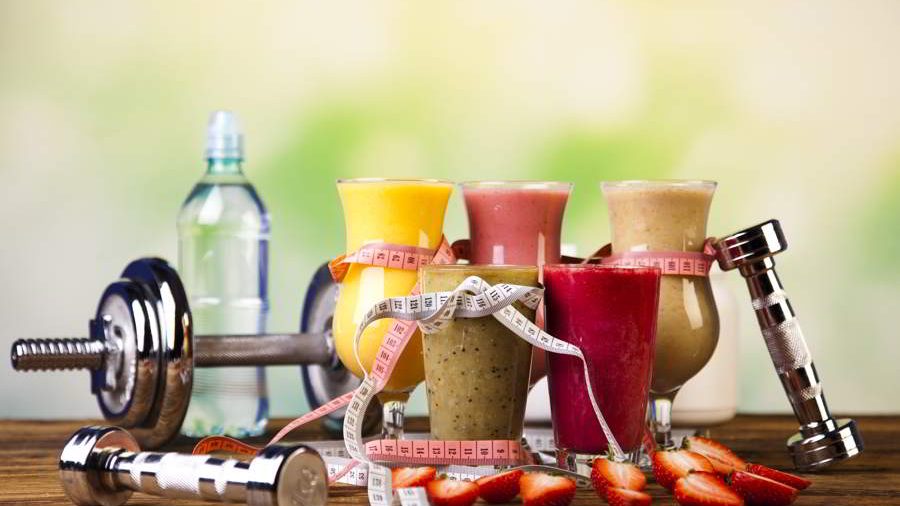Last Updated on September 6, 2020 by Nick

Super health foods in bowls on a wooden board
If you have ever struggled with losing weight, you have probably heard about speeding up your metabolism, the dangers of slowing it down, and finally damaging or breaking your metabolism. This information might be confusing and overwhelming.
All you want to do is lose some weight but what if you are hurting yourself instead? Is it possible to break your metabolism? And if you can, how do you fix a broken metabolism?
We’re going to learn what exactly your metabolism is, whether it can be broken, how you can fix it, what a healthy metabolism feels like, and why it’s important to your overall health.
Contents
- 1 What Is Metabolism?
- 2 What Is A Broken Metabolism?
- 3 Metabolic Damage And Weight Gain Controversy
- 4 How Your Body Actually Burns Energy (And The Concept Energy In vs. Energy Out)
- 5 Ways To Fix Broken Metabolism
- 5.1 1. Speeding Up Your Metabolism (Eat Less Exercise More Is BAD Strategy)
- 5.2 2. Variations And Carb Cycling
- 5.3 3. Can You Reset Your Metabolism By Fasting?
- 5.4 4. Processed vs. Unprocessed Foods
- 5.5 5. Watch For The Types Of Calories You Are Eating (Good Calories vs. Bad Calories)
- 5.6 6. Lean Healthy Proteins (Go Beyond Chicken And Protein Powder)
- 5.7 7. Increase Your Daily Servings Of Vegetables And Fruits (Boost Your Metabolism Naturally)
- 5.8 8. Carbs Are Necessary (But It’s The Quality That Counts)
- 5.9 9. Increase Your Healthy Fat Intake (Aim For The Good Fats)
- 5.10 10. Metabolism Supplements (And Why You Should Avoid Them)
- 5.11 11. Increase Your Physical Activity (Get Fit YOUR Way)
- 5.12 12. Cardiovascular Training (Stop Dieting And Burn Stubborn Fat For GOOD)
- 5.13 13. Rest And Recovery (And Why It Is So Important)
- 6 Finally…
What Is Metabolism?
Metabolism is how your body converts what you eat and drink into energy, or fuel. If you want a more technical definition, metabolism is all the chemical processes your body does to stay alive.
It’s a complicated process that does not always run perfectly.
It changes based on how you eat, drink, and move.
What Is A Broken Metabolism?
A broken metabolism is a bit of a misnomer. You cannot permanently break your metabolism, because it must work for you to function. But you can damage your metabolism by altering how your body reacts to food and exercise.
Your body wants to adapt to changes in eating or exercise because it wants to maintain its current state. If you have crashed dieted or exercised excessively in the past, you have changed your metabolism enough that it could be referred to as damaged, broken, or underperforming.
Why? Because your metabolism is not working at its optimal state.
A broken metabolism often manifests itself as a handful of unrelated illnesses or feelings that are easily ignored as other maladies.
People often experience irritability, exhaustion, or insomnia, which are often attributed to depression, which is also a key sign of your metabolism not working properly.
This is usually not permanent; if you take the steps to identify what you are doing wrong, fixing your metabolism can be quite easy.
Metabolic Damage And Weight Gain Controversy
There is controversy about whether weight gain is caused by a broken metabolism. Our bodies are all unique. Food, exercise, and environment will affect each person differently. As we age, we move less. This has nothing to do with our bodies’ natural metabolic process.
Instead, how we treat our bodies’ seems to have a bigger effect on consistent weight gain. If you do not consistently make healthy food and exercise choices, you will either gain weight or stop losing.
Part of the problem of weight gain or plateaus in a diet regimen is that once your metabolism adapts to your adjusted calorie intake, it begins to store more fat in a process called homeostasis.
Yo-yo dieting and fad diets often lead to more weight gain later on down the line, as we’ve all experienced. And that weight then becomes even harder to lose than it was the first ten times.
How Your Body Actually Burns Energy (And The Concept Energy In vs. Energy Out)
Your body must use energy (calories) to keep you alive. In simple terms, energy in is the food you take in, though it is a little more complicated. Not all calories are created equal, and unfortunately there are hidden calories in our food.
There is a little known fact that the labels can easily be off by approximately 25%. (Take a look here to learn more about the hidden calorie conundrum.)
Then there is the additional complication of our body’s ability to absorb the nutrients we consume, and the way it absorbs certain types of foods such as cooked vs. raw foods, and of course last but not least, the various types of bacteria in our digestive tract plays a part as well.
While energy out combines, both physical exertion, which includes exercise frequency, and the type and intensity of the workout, as well as standard bodily motion. This involves the complex variations of the following:
- RMR or resting metabolic rate
- TEE or thermic effect of eating
- NEAT or non-exercise activity thermogenesis
- PA or physical activity
The number of calories burned to keep you alive is your resting metabolic rate, or RMR. It is the bare minimum of calories needed for you to breathe and digest nutrients. Your resting metabolic rate is basically set by your genetics and there isn’t much you can do to change this.
The thermic effect of eating is a simple method of eating food that takes more energy or work for your body to digest and process the nutrients.
You also burn calories by moving around daily. This is called NEAT or non-exercise activity thermogenesis.
Your non-exercise activity is a combination of your every day movement that you don’t put much thought into such as fidgeting, or walking up the stairs, or from one room to another, you are moving, but you are not doing strenuous exercises.
There is one more way to burn energy that you’re all familiar with – exercise. (We’ll talk more about this later.) In short, physical activity refers to your actual efforts at exercise.
Your body gets the energy to perform RMR, NEAT, and other processes from two sources – the calories (energy) you take in and those stored in your body (aka fat).
Now that we know more about metabolism and its effect on our bodies, let’s look at ways we can speed up your metabolism to burn more fat and lose weight.
Ways To Fix Broken Metabolism
Putting your metabolism on the right track is not a one-way street. There are things you can do to “repair the damage” if you will, however there are other things that you just have to STOP doing in order to get there.
Here’s a list of both:
1. Speeding Up Your Metabolism (Eat Less Exercise More Is BAD Strategy)
Many people assume the best way to lose weight is to drastically cut calories and exercise extensively. They think this will jump start their metabolism and burn more calories. This is not a good way to lose weight.
The key to resetting your metabolism long term is not simply eating less and exercising more, because this causes your body to adjust and slow down energy use to vital organs. Instead it’s about balance, or moderation.
Making sure that the food you eat is what your body needs for fuel, and not storage.
If you cut your calories too low and begin to eat less without your body absorbing the necessary nutrients, your body will go into storage mode faster and it will think it is entering a period of starvation. It will then hang on to the calories you take in, instead of burning them.
This leads to fat storage, because your body thinks it will need it for energy at a later time. Your body wants to survive. If it thinks it is threatened, it will do what it takes to keep everything the same!
This can lead to your body absorbing more calories, though not the nutrients, you eating more calories, and your body adjusting your resting metabolic rate, and your non-exercise activity thermogenesis.
2. Variations And Carb Cycling
Regularly changing your diet can trick your body into letting go of stored fat. If you’ve ever heard of carb cycling, you might be familiar with this idea. Carb cycling is an advanced diet regimen that helps with balancing your ketones so that you continue to burn fat.
The most common approach is to maintain a level intake of fats and proteins while adjusting the carbohydrate intake.
Instead of eating the same number of calories and macronutrients every day, you change it every 2-3 days. For example, you begin by eating low carb foods for 2-3 days in a row. Then you eat high carb foods for an entire day.
Repeat this cycle every 3-4 days. You can change the ratio of high to low carb days, depending on your weight and exercise goals.
By changing up your eating habits, your body cannot adapt to any one pattern. The periodic carb reloads also reassure your body that there is no starvation happening, so it does not need to hang onto extra calories for later use.
On high carb days it’s also recommended to do heavier weight lifting/muscle toning exercises or resistance training at the gym to balance the higher carbs in and the higher physical activity.
When you are doing a carb cycle, it is important to keep a close eye on the ketones your body may be producing.
Ketones in your urine is an indicator that your body is burning fat, because there are not longer any available carbohydrates to burn for energy.
When this happens your body will go into conservation mode, and begin limiting the energy it extends to vital parts of your body. For maximum weight loss your ketone level should always be around 1.5 – 3 mmol/L which is known as optimal ketosis.
Anything below or above that range is considered light, moderate or too high, and it is not desired.
3. Can You Reset Your Metabolism By Fasting?
Fasting can also help reset your metabolism. When you deprive your body of food, it decreases insulin and glycogen production. These are your body’s first choice of fuel, so it will be forced to use back up fuel, stored fat.
This teaches your body to use fat instead of only storing it away for a rainy day.
Remember, your body desperately wants that energy, so fasting is most effective in short doses. Otherwise, you’ll be back to starvation mode and unnecessary fat production and storage.
You can fast for as little as 18 hours and still benefit from the decrease in insulin production.
According to WebMD, fasting for the sake of fasting, will do nothing to cleanse you or “detox” you, and it doesn’t help with long term weight goals.
There is just no scientific evidence to back up the claims many fad diets and “detox” programs promise.
Long term fasting actually does quite the opposite, it slows your metabolism, instead of speeding it up, and if you are not careful, this can have negative side effects to your kidneys or liver.
4. Processed vs. Unprocessed Foods
Eating whole, unprocessed foods will also increase your metabolism. If you eat lots of processed foods, then you are making digestion too easy on your body.
Your body does not have to work as hard to convert processed foods to energy or fat because it is already processed.
When you eat unprocessed foods, you use more energy just to break the food down. This is called the Thermic Effect of Eating or Thermic Effect of Food. Amazingly, you burn more calories just by eating, thereby increasing your metabolism.
Eating more natural and unprocessed foods is also a key factor in balancing your body’s regulation of carbohydrates and fat. Green vegetables and salads are highly thermic meaning that your body burns more calories as it is digesting these foods.
The problem with processed foods such as ready to eat or packaged meals like TV dinners, boxed or bagged meals, chips and cookies are the hidden ingredients, or the quality of ingredients.
Things to avoid or eat minimally:
- Trans Fats
- Saturated Fats
- Hydrogenated Oils
- BHT
- Polysorbate 80
- Refined Grains
- Sugar
- Natural Flavors
5. Watch For The Types Of Calories You Are Eating (Good Calories vs. Bad Calories)
There is no such thing as a good calorie vs. a bad calorie per say, more of a useful food for nutrients and energy, and those considered to have no purpose, these are referred to as empty calories. Examples of foods with little to no nutritional value are:
- Sugars
- High Fructose Corn Syrup
- Alcohol
- Fruit Juices
- Bacon
- Margarine
- White Bread
- American Cheese
Sugar is a common ingredient in most processed foods, and is often found in high quantities in things you would commonly find healthy such as fruit juices.
Processed foods like bacon, margarine, American cheese and white breads hold more calories than nutritional values, consisting mostly of filler ingredients. Processed meats are especially a concern for those trying to be heart healthy.
If you eat 1500 calories a day of healthy, whole foods, instead of 1500 calories of processed junk foods, you will see a major difference in your body. You need a variety of foods to properly fuel every cell in your body.
If you are deficient in one area, it will throw everything off, slowing your metabolism and your weight loss. Choose minimally processed foods that provide healthy protein, fat, and carbs.
6. Lean Healthy Proteins (Go Beyond Chicken And Protein Powder)
Protein is necessary for developing and maintaining lean muscle. It is also more filling than carbohydrates, which will help you not overeat. If you suffer any type of injury, protein is necessary for quick and efficient healing.
You don’t have to saturate your diet with protein, but include it in each meal. A serving is about the size of your palm, so the amount of protein needed varies. Aim for at least five servings of protein a day, but increase this if you want to build large muscles.
Increasing your protein intake, is a significant way to satisfy your body’s hunger, while feeling fuller faster and longer.
This helps you eat less not only at mealtime, but throughout the day as well. Meats that are high in lean proteins like chicken, fish or turkey are also highly thermic. You can find a list of protein-rich foods here.
7. Increase Your Daily Servings Of Vegetables And Fruits (Boost Your Metabolism Naturally)
Eats lots of vegetables and some fruit. Vegetables are the best thing you can eat in large quantities. They provide just about every vitamin and mineral your body needs. The bulk of your carbohydrates (which we will discuss next) should come from veggies and fruit.
This will reduce your glycemic load, lowering insulin production, and forcing your body to rely on stored fat for fuel. Vegetables are also low in calories, so you can consume large quantities and not worry about weight gain.
The high fiber content in vegetables and fruits keeps the digestive system moving by cleaning the colon. The high fiber is also filling, and the low calories make it an ideal staple for your daily intake.
Vegetables are also a great source of vitamins and minerals, which keep you healthy enabling you to maintain your weight goals. Make sure you are eating whole fruits and not simply juices, as the whole fruit has more fiber and less sugar.
8. Carbs Are Necessary (But It’s The Quality That Counts)
Eat quality carbohydrates. A “good” carbohydrate is fruits, whole grains, beans, and vegetables. They digest and absorb slowly, preventing spikes or crashes in blood sugars, because of the amount of fiber that can also be found in these foods.
Ditch the pasta and bread and opt for healthy carbs like sweet potatoes, quinoa, and steel cut oats. You’ll find that the diet and fitness community is sharply divided on the subject of carbs. Look at your lifestyle and your body to decide on how many and what type of carbs to eat.
Some people thrive on very few carbs that come only from vegetables. Others rely on oats, quinoa, and beans to fuel their intense workouts.
9. Increase Your Healthy Fat Intake (Aim For The Good Fats)
Find good fat. Yes, good fats do exist. Like protein, fat makes you full for longer. Starting your day with eggs and sausage will help you skip the mid-morning crash and desperate rush for lunch at 11 am.
Avocado oil, coconut oil, extra virgin olive oil, and grass fed butter are all good fats for cooking. Avoid vegetables oils and moderate your animal fat intake.
If you are interested in eating a ketogenic diet, then fat will make up the bulk of your diet. You’ll force your body to use fat for energy and slowly replace the bad fat in your body with healthy fat and muscle.
Increasing healthy fats from Omega 3’s helps maintain a healthy heart.
Omega 3’s are found in fish oils, or fatty fishes such as salmon, tuna, striped bass or trout.
Nuts like almonds, walnuts, pecans and flaxseed are considered healthy fats. They also have Omega 3’s though in smaller amounts.
Avocados that are firm, or just barely ripe, are cholesterol free, are loaded with vitamins C and E, potassium, and fiber, and are a great source of heart-healthy monounsaturated fat.
10. Metabolism Supplements (And Why You Should Avoid Them)
Supplement with caution. Do not rely on supplements to fix your metabolism. Some can give you a little boost, but they will not cure you. If you can handle caffeine, include it in your diet to help burn a few extra calories.
It can also be used before workouts to increase your energy. Green tea or black coffee is a good source of caffeine.
Many pill supplements are not FDA approved, so do your research. Always read the labels. Make sure you know and understand what is going into your body.
The FDA regulates vitamins and dietary supplements but they consider them foods, and not medication, giving them a more lenient oversight. Most supplements do not have reliable evidence showing long-term benefits to their claims.
Some of these can be downright dangerous if you are not careful, because the FDA does not require supplement manufacturers to prove the safety of the product before sale, and are not required to tell you the side effects on the label.
Instead you should focus on supplements for improved overall health for your age, and dietary needs such as:
- Fish Oil Supplements
- Multi-vitamins
11. Increase Your Physical Activity (Get Fit YOUR Way)
Build muscle through exercise. Muscle burns more calories than fat. It will automatically boost your RMR, which means you are burning more calories by just breathing. Begin with body weight exercise or light weights.
Increase your weight and reps over time or you will not increase muscle mass. Don’t worry that you might bulk up. Most people can lift heavy weights and only build lean muscle. Start with a minimal regimen at first with low impact exercises, building your endurance slowly.
Walking helps build muscles and endurance without overextending yourself.
Focus on strength training to build muscle. If you choose to carb cycle, time your high carb days with heavy lifting sessions and workouts to maximize the benefits.
12. Cardiovascular Training (Stop Dieting And Burn Stubborn Fat For GOOD)
Cardiovascular exercise is also important. You don’t have to become a runner (unless you want to). Instead, opt for walks, bike rides, and swimming. You also don’t need to stay on the treadmill for an hour. Thirty minutes every day is fine.
You can also combine strength training with cardio by doing high intensity interval training (HIIT). High Intensity Interval Training or HITT sessions are cardio conditioning sessions and should be done in short bursts.
Be careful of health issues, and consult a doctor before beginning a high intensity program.
These short sessions are designed to burn fat and increase calorie burn even after you finish your workout. You can do HIIT exercises 3-5 times a week, depending on your fitness level. Start with just 3 and then build your way up.
Remember, you need to rest to let your body recover. Which leads us to our last point.
13. Rest And Recovery (And Why It Is So Important)
Get plenty of rest. You may be tempted to constantly exercise, but your body has to rest in order to build muscle. Take days off. Focus on other things, like family, friends, or other hobbies.
Prioritize sleep.
Shoot for 8 hours or more a night. When you don’t get enough sleep, your body can’t regulate itself properly. You’ll also increase production of stress hormones, which will then increase fat storage.
Finally…
In the end, the key to a healthy lifestyle, losing weight, maintaining a healthy weight, or adjusting your metabolic rate is stability.
A consistent approach to what you eat, how you eat, and how much you eat are all important parts of the way you train your body to burn fat and build muscle instead of storing those nutrients for later.
Regular exercise or even just increased mobility is also an important part, as well as regulating your insulin, or sugar balance.
Remember, your body will always adjust to your eating and exercise habits in order to maintain its current state. If you find yourself stuck in a weight loss plateau, don’t despair. It is totally normal and does not mean your metabolism is broken beyond repair.
Be patient with yourself as you change up your current routine.
Try eating and exercising less for 2-3 weeks. Or, ramp up your gym time, but be sure to increase your food intake as well. With a healthy diet, consistent exercise, and patience, you can get your metabolism back on track and losing weight within a few weeks.
Managing a consistent sleep schedule, and low stress environment are also a key component to maintaining a healthy life.





nice blog..
Excellent read